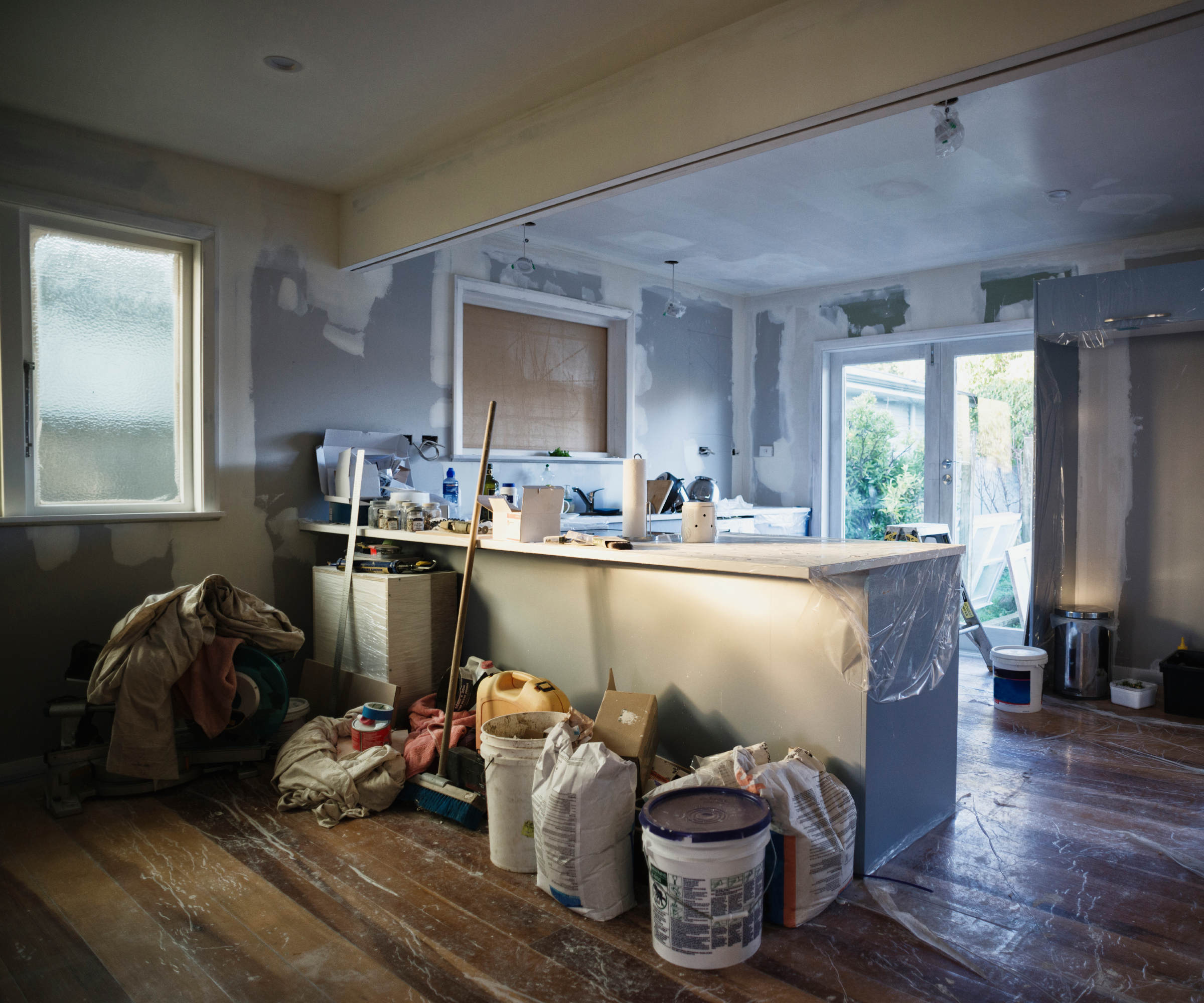What to know if you're thinking of buying a house without building regulations
Renovations or extensions on the home you want to buy completed without building regulations approval? This is what you need to know

The building regulations apply to many home projects from fitting new windows to extending, but when you’re thinking of purchasing a property you might find that the seller went ahead with them without obtaining building regulations approval.
Its lack might come to light during the work your conveyancer undertakes when you’re buying a house. Alternatively, you might find out when you’re viewing. But either way it raises issues about the purchase.
Here, we’ve put together a guide to the implications of the lack of building regulations approval, including what it might mean about the home’s safety, its effect on getting a mortgage and more.

Why building regulations matter

Find your perfect building plot with Plotfinder.net – the UK's largest plot and renovation-finding platform, with over 15,000 opportunities available.
The building regulations are important because they set standards to ensure a home is safe and comfortable to live in, and that it’s energy efficient. They cover both new buildings and extensions and alterations to existing homes, which includes projects such as adding extra radiators or installing or replacing a heating system, replacing fuse boxes, replacing roof coverings, installing a bathroom and more.
Below is what you need to know when you’re buying.
Why building regulations approval is different from planning permission
Although it can cause confusion, there is a difference between planning permission and building regulations and there can also be a difference when it comes to the period during which enforcement action can be taken by the local authority if the necessary approvals for home projects aren’t in place.
If changes are made to a home without the planning permission required, enforcement action used to be subject to a four-year rule, after which it couldn't be taken unless the homeowner deliberately concealed the work. However, this was amended to a 10 year rule – allowing action to be taken within a 10 year period. For some projects, the four-year rule still applies, but it depends on when the project was mostly completed.
When it comes to building regulations the enforcement period is normally 10 years. “Once 10 years have elapsed since completion of the works, most methods of enforcement by the local authority become time-barred although enforcement via a court injunction remains theoretically possible though they are rarely utilised,” says Natalie Beard, conveyancer at SAS Daniels.

Natalie Beard is a conveyancer in SAS Daniels’ residential property team. She has nine years’ experience working in conveyancing and is experienced at dealing with both existing homeowners and those embarking on the property ladder for the first time.
Pros and cons of buying a home without building regulations approval
Lack of building regulations approval should give you pause when buying a home and there are two downsides to buying a property without them.
First, the local authority can take enforcement action, as noted above. “It is the homeowner at the time of discovery who is liable for any breach and thus it will not matter if it was a previous owner who carried out the work,” Natalie Beard explains.
Secondly, there’s peace of mind. “Building regulations function as a marker of quality and safety,” she says. “A failure to obtain consent could raise questions as to the quality of the work and potentially its safety and (depending on the work) its structural integrity.”
An upside to a lack of approval might be saving on the purchase. “A home that’s been altered or modernised without building regulations approval is much harder to sell,” says Thomas Goodman, construction expert at MyJobQuote. “This means that they’re often priced below the market value. So, you could get a bargain.”
This isn’t necessarily the case, though. “You do need to exercise some caution as the savings you make on the purchase price could soon be eaten up if the house requires extensive remedial work or is subject to enforcement action by the local authority,” he says.

Thomas Goodman has worked as a property and construction expert for MyJobQuote for six years and has worked in the construction industry for more than 20 years. Thomas continues to work on building projects, while also providing expert construction and property advice to industry professionals and DIY enthusiasts.
What can you do if building regulations consent is missing?
If you discover a home that you want to buy doesn’t have building regulations approval, there are options.
Since enforcement might be a possibility taking out indemnity insurance provides cover.
“It is common for a buyer’s solicitor to ask the seller’s solicitor to provide an indemnity policy once works are discovered that are potentially in breach of building regulations where these works were carried out in the last 10 years,” says Natalie Beard. “These policies seek to cover the buyer financially (subject to its conditions and exclusions) for the consequences of enforcement action although it is important to note that they cannot prevent the action being taken.”
But if you take the indemnity insurance route, you should still be cautious. “Safety and the overall quality of the structure/installation remain a concern that an indemnity policy cannot resolve,” Natalie says. And don’t forget that the same applies if you consider buying without indemnity insurance and regardless of finding building regulations approval is missing.
Retrospective approval is another avenue. “The only way to completely remove the risk of enforcement is to have the work retrospectively signed off by the local authority or, in the case of the installation of some appliances, by the relevant regulatory body,” says Natalie.
Bear in mind the consequences of doing so, however. “Approaching the local authority will unfortunately make indemnifying against the breach impossible and if the local authority requires works to be done to make the structure compliant, this could cause delays and expense,” she says.
Another possibility is to get the work checked by a qualified individual/company, Natalie says. “This can provide comfort that a structure/appliance is safe potentially without approaching the council and invalidating any indemnity policy.”
Assessing costs
It’s vital to consider expense if you’re considering going ahead with the purchase. “Enforcement action may result in unapproved work being taken down,” says Thomas Goodman.
“As the new owner, you are liable for any costs incurred because of this, unless indemnity insurance has been taken out. However, so long as the relevant planning permissions were granted, it’s more likely that you’ll be given a set period of time to remedy the work. This does mean that you’ll need to have plenty of money available for anything that crops up.”
For older renovations and with enforcement mostly time barred, it’s a little different. “It’s a case of getting the house assessed by the relevant trades and ensuring that all remedial work is completed with the correct certification,” says Thomas. “That said, it’s essential to know what you are letting yourself in for before you buy as this could be a costly exercise.”
It’s preferable to know what work might be needed before you make an offer. “It’s important to get in-depth surveys done and, ideally, take a structural engineer and builder with you to view the property before you make an offer,” says Thomas. “They will be able to advise you on the possible costs and you can use this to negotiate a reasonable sale price. If a structural engineer expresses any major concerns though, it’s best to listen to these and be prepared to pull out of the deal.”
And if you find that building regulations consent is missing during the conveyancing process, calling in qualified individuals or companies to check the work can enable you to renegotiate the price at which you buy according to what remedial work might cost.

Take your mortgage into account
When you’re buying a house with a mortgage, the absence of building regulations consent matters.
“It wouldn’t impact your ability to get a mortgage in principle at least initially,” explains Mark Harris, chief executive of mortgage broker SPF Private Clients. “However, once the standard conveyancing part of the homebuying process got underway, any building regulation issues would be uncovered, which is where the process could grind to a halt.”
And while you might not think indemnity insurance is necessary, it will become imperative to get things moving. “Even if a buyer is not concerned about the risk of enforcement, if they are buying with the assistance of a mortgage, their lender will need a policy put in place to protect their interest,” says Natalie Beard.
But be aware that this may not be sufficient. “In some cases as well, such as with loft conversions, lenders will often not accept indemnity policies and may insist the work is checked by a structural engineer or that the local authority issue retrospective consent which could cause problems and delays if remedial works are required before the local authority will sign off the work,” she says.

Mark Harris is chief executive of mortgage broker SPF Private Clients, and was part of the launch team of the company as Savills Private Finance in May 1997. Originally launching as the financial services arm of Savills, SPF has rapidly grown into one of the market leaders in UK financial services. SPF became part of the Howden Group of companies in 2022.
Selling on
Even when you’re at the buying stage, it’s worth considering what might happen when you come to sell a home that had work done without building regulations approval.
“When buying a house with a suspected breach, ensure you obtain an indemnity policy from the seller if the breach is less than 10 years old,” says Natalie Beard. “This can then be passed on to a new buyer when you sell although care must be taken to ensure the policy limit covers any increase in value to the property.”
Remember, too, that when you sell on, a buyer might have the same concerns as you did as a buyer and ask for works to be checked.
“Breaches of building regulations are a common find in conveyancing and most of the time do not present a problem or much of a delay,” says Natalie Beard. However, never forget that safety and structural integrity matter, as does the energy efficiency of home.

Plotfinder.net is Homebuilding & Renovating's sister site that has thousands of self build and renovation opportunities from estate agents, auction sites and private owners across the UK. Subscribe today and get email alerts for potential plots straight to your inbox.
Get the Homebuilding & Renovating Newsletter
Bring your dream home to life with expert advice, how to guides and design inspiration. Sign up for our newsletter and get two free tickets to a Homebuilding & Renovating Show near you.
Sarah is a freelance journalist and editor writing for websites, national newspapers, and magazines. She’s spent most of her journalistic career specialising in homes.
She loves testing the latest home appliances and products, and investigating the benefits, costs and practicalities of home improvement. She is an experienced renovator and is currently remodelling the ground floor of her new home.
She was Executive Editor of Ideal Home and has worked for Your Home and Homes & Ideas. Her work has published by numerous titles, including The Guardian, channel4.com, Houzz, Grand Designs, Homes & Gardens, House Beautiful, Homes & Antiques, Real Homes, The English Home, Period Living, Beautiful Kitchens, Good Homes and Country Homes & Interiors.
